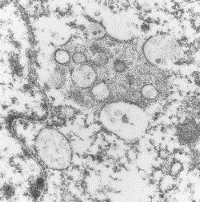Australian Bat
Lyssavirus
|
|
|
Bat Lyssavirus
http://www.csiro.au/index.asp?type=faq&id=BatLyssavirus&stylesheet=sectorInformationSheet |
“G’day mate. Lemme have a bite.” –
Australian bat infected with Australian Bat Lyssavirus.
Queensland health. Australian Bat Lyssavirus.
http://www.health.qld.gov.au/healthyislandresorts/topic/abl.htm
|
Description:
Australian Bat Lyssavirus is a
virus that was first identified in 1996 in bats and flying foxes in Australia,
and it can be transmitted to humans. Two people have died from infections with
Australian Bat Lyssavirus since the virus’ discovery. Australian Bat Lyssavirus
is a member of the Rhabdoviridae family of viruses, and is very similar to
Rabies, another member of the Rhabdoviridae family. It is an RNA,
single-stranded helical virus with a bullet shaped morphology.
Power:
This is a very deadly disease:
2 deaths out of 2 infections have occurred. Rabies-like neurological symptoms
ensue for a 20 day period, which are brought to an end by the patient’s
death.
Offenses:
Attacks: ABL attacks the host’s
central nervous system much like Rabies. The initial CNS symptoms are confusion
and agitation, and the later CNS symptoms include hallucinations and
convulsions.
Outcome: The illness stage of
infection usually begins with the patient presenting influenza-like symptoms
(fever, malaise, headache, anorexia) as well as nausea and vomiting. The
symptoms progress into encephalitis (characterized by delirium, hallucinations,
convulsions) and eventual brain stem dysfunction which is often characterized by
difficulty swallowing and “foaming at the mouth.” This is an extremely fatal
disease if pre or post exposure prophylaxis is not administered to exposed
individuals.
Speed: The exact incubation
period of ABL in humans is unknown because there have only been two cases. In
the first case, the incubation period was approximately 4 to 5 weeks, and the
other 6 months. Death resulted in both cases 20 days after the onset of illness.
Defenses:
Vaccines: Pre-exposure vaccines
are recommended for individuals who handle bats. This vaccine is the same
inactivated Rabies virus, (given in a series of three injections at days 0, 7
and 21), that is given for typical Rabies prevention.
Behavioral: Avoiding contact
with infectious bats is important. Individuals who handle bats are encouraged to
avoid getting bitten and scratched. If these individuals happen to get bitten
they are encouraged to wash the wound with soap and water and to contact public
health authorities immediately.
Treatment: Post-exposure
prophylaxis is available for individuals who are at risk of having had contact
with ABL. Post-exposure treatment can be both the inactivated Rabies virus (5
injections given at days 0, 3, 7, 14 and 28) in addition to Rabies immune
globulin which is administered once.
Game action:
Bonus: Move up three places.
You are in a hurry to get to the local public health office to receive
post-exposure prophylaxis because you just got bitten by a scrappy little bat
while you were at a petting zoo in Australia. Run, run!!! (But don’t forget to
wash the wound with soap and water first!)

